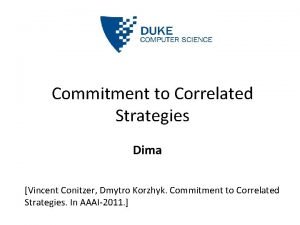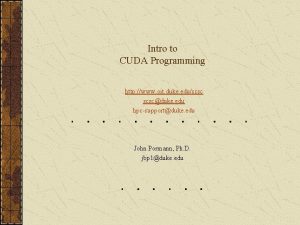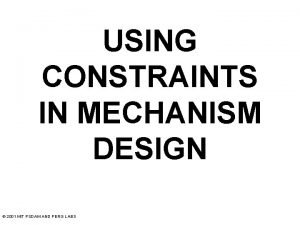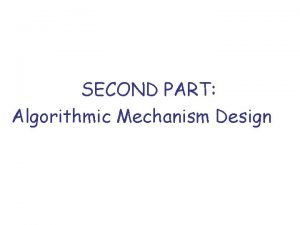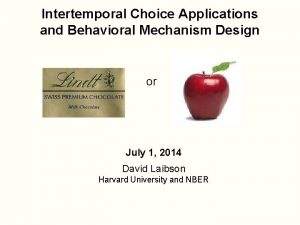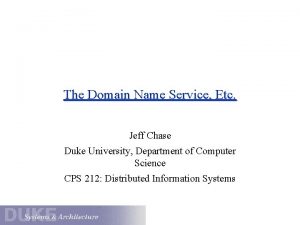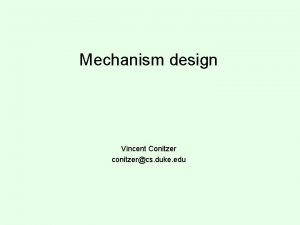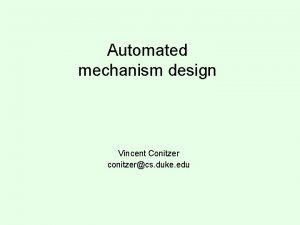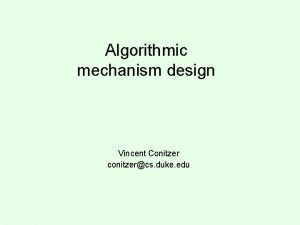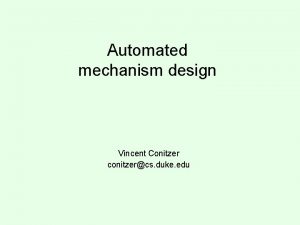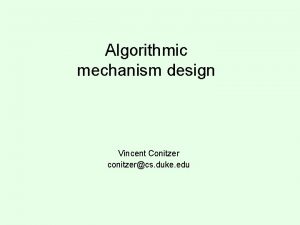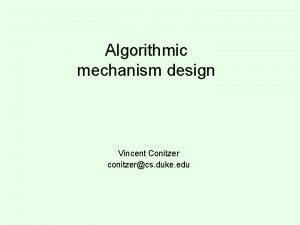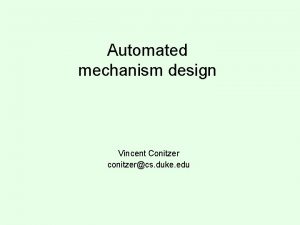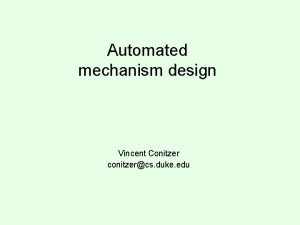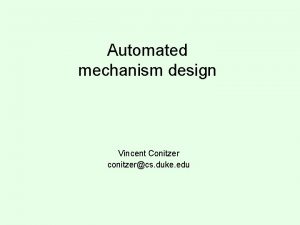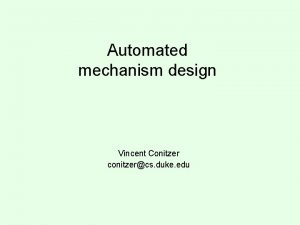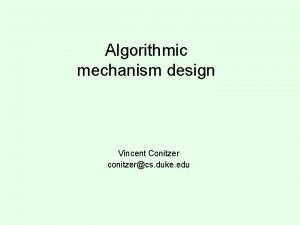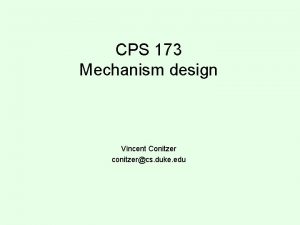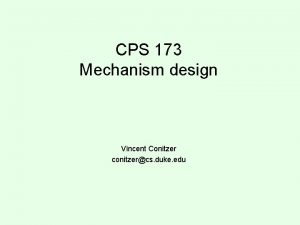Mechanism design Vincent Conitzer conitzercs duke edu Mechanism





![The Clarke (aka. VCG) mechanism [Clarke 71] • The Clarke mechanism chooses some outcome The Clarke (aka. VCG) mechanism [Clarke 71] • The Clarke mechanism chooses some outcome](https://slidetodoc.com/presentation_image_h/124bde7a20c6f94262df8122b3e4e285/image-6.jpg)








![Myerson-Satterthwaite impossibility [1983] • Simple setting: v( )=x v( )=y • We would like Myerson-Satterthwaite impossibility [1983] • Simple setting: v( )=x v( )=y • We would like](https://slidetodoc.com/presentation_image_h/124bde7a20c6f94262df8122b3e4e285/image-15.jpg)

- Slides: 16

Mechanism design Vincent Conitzer conitzer@cs. duke. edu

Mechanism design: setting • The center has a set of outcomes O that she can choose from – Allocations of tasks/resources, joint plans, … • Each agent i draws a type θi from Θi – usually, but not necessarily, according to some probability distribution • Each agent has a (commonly known) valuation function vi: Θi x O → – Note: depends on θi, which is not commonly known • The center has some objective function g: Θ x O → – – Θ = Θ 1 x. . . x Θn E. g. , efficiency (Σi vi(θi, o)) May also depend on payments (more on those later) The center does not know the types

What should the center do? • She would like to know the agents’ types to make the best decision • Why not just ask them for their types? • Problem: agents might lie • E. g. , an agent that slightly prefers outcome 1 may say that outcome 1 will give him a value of 1, 000 and everything else will give him a value of 0, to force the decision in his favor • But maybe, if the center is clever about choosing outcomes and/or requires the agents to make some payments depending on the types they report, the incentive to lie disappears…

Quasilinear utility functions • For the purposes of mechanism design, we will assume that an agent’s utility for – his type being θi, – outcome o being chosen, – and having to pay πi, can be written as vi(θi, o) - πi • Such utility functions are called quasilinear • Some of the results that we will see can be generalized beyond such utility functions, but we will not do so

Definition of a (direct-revelation) mechanism • A deterministic mechanism without payments is a mapping o: Θ → O • A randomized mechanism without payments is a mapping o: Θ → Δ(O) – Δ(O) is the set of all probability distributions over O • Mechanisms with payments additionally specify, for each agent i, a payment function πi : Θ → (specifying the payment that agent must make) • Each mechanism specifies a Bayesian game for the agents, where i’s set of actions Ai = Θi – We would like agents to use the truth-telling strategy defined by s(θi) = θi
![The Clarke aka VCG mechanism Clarke 71 The Clarke mechanism chooses some outcome The Clarke (aka. VCG) mechanism [Clarke 71] • The Clarke mechanism chooses some outcome](https://slidetodoc.com/presentation_image_h/124bde7a20c6f94262df8122b3e4e285/image-6.jpg)
The Clarke (aka. VCG) mechanism [Clarke 71] • The Clarke mechanism chooses some outcome o that maximizes Σi vi(θi’, o) – θi’ = the type that i reports • To determine the payment that agent j must make: – Pretend j does not exist, and choose o-j that maximizes Σi≠j vi(θi’, o-j) – j pays Σi≠j vi(θi’, o-j) - Σi≠j vi(θi’, o) = Σi≠j (vi(θi’, o-j) - vi(θi’, o)) • We say that each agent pays the externality that she imposes on the other agents • (VCG = Vickrey, Clarke, Groves)

Incentive compatibility • Incentive compatibility (aka. truthfulness) = there is never an incentive to lie about one’s type • A mechanism is dominant-strategies incentive compatible (aka. strategy-proof) if for any i, for any type vector θ 1, θ 2, …, θi, …, θn, and for any alternative type θi’, we have vi(θi, o(θ 1, θ 2, …, θi, …, θn)) - πi(θ 1, θ 2, …, θi, …, θn) ≥ vi(θi, o(θ 1, θ 2, …, θi’, …, θn)) - πi(θ 1, θ 2, …, θi’, …, θn) • A mechanism is Bayes-Nash equilibrium (BNE) incentive compatible if telling the truth is a BNE, that is, for any i, for any types θi, θi’, Σθ-i P(θ-i) [vi(θi, o(θ 1, θ 2, …, θi, …, θn)) - πi(θ 1, θ 2, …, θi, …, θn)] ≥ Σθ-i P(θ-i) [vi(θi, o(θ 1, θ 2, …, θi’, …, θn)) - πi(θ 1, θ 2, …, θi’, …, θn)]

The Clarke mechanism is strategy-proof • Total utility for agent j is vj(θj, o) - Σi≠j (vi(θi’, o-j) - vi(θi’, o)) = vj(θj, o) + Σi≠j vi(θi’, o) - Σi≠j vi(θi’, o-j) • But agent j cannot affect the choice of o-j • Hence, j can focus on maximizing vj(θj, o) + Σi≠j vi(θi’, o) • But mechanism chooses o to maximize Σi vi(θi’, o) • Hence, if θj’ = θj, j’s utility will be maximized! • Extension of idea: add any term to agent j’s payment that does not depend on j’s reported type • This is the family of Groves mechanisms [Groves 73]

Individual rationality • A selfish center: “All agents must give me all their money. ” – but the agents would simply not participate – If an agent would not participate, we say that the mechanism is not individually rational • A mechanism is ex-post individually rational if for any i, for any type vector θ 1, θ 2, …, θi, …, θn, we have vi(θi, o(θ 1, θ 2, …, θi, …, θn)) - πi(θ 1, θ 2, …, θi, …, θn) ≥ 0 • A mechanism is ex-interim individually rational if for any i, for any type θi, Σθ-i P(θ-i) [vi(θi, o(θ 1, θ 2, …, θi, …, θn)) - πi(θ 1, θ 2, …, θi, …, θn)] ≥ 0 – i. e. , an agent will want to participate given that he is uncertain about others’ types (not used as often)

Additional nice properties of the Clarke mechanism • Ex-post individually rational (never hurts to participate), assuming: – An agent’s presence never makes it impossible to choose an outcome that could have been chosen if the agent had not been present, and – No agent ever has a negative value for an outcome that would be selected if that agent were not present • Weakly budget balanced - that is, the sum of the payments is always nonnegative - assuming: – If an agent leaves, this never makes the combined welfare of the other agents (not considering payments) smaller

Generalized Vickrey Auction (GVA) (= VCG applied to combinatorial auctions) • Example: – Bidder 1 bids ({A, B}, 5) – Bidder 2 bids ({B, C}, 7) – Bidder 3 bids ({C}, 3) • Bidders 1 and 3 win, total value is 8 • Without bidder 1, bidder 2 would have won – Bidder 1 pays 7 - 3 = 4 • Without bidder 3, bidder 2 would have won – Bidder 3 pays 7 - 5 = 2 • Strategy-proof, ex-post IR, weakly budget balanced • Vulnerable to collusion (more so than 1 -item Vickrey auction) – E. g. , add two bidders ({B}, 100), ({A, C}, 100) – What happens? – More on collusion in GVA in [Ausubel & Milgrom 06, Conitzer & Sandholm 06]

Clarke mechanism is not perfect • Requires payments + quasilinear utility functions • In general money needs to flow away from the system – Strong budget balance = payments sum to 0 – In general, this is impossible to obtain in addition to the other nice properties [Green & Laffont 77] • Vulnerable to collusion – E. g. , suppose two agents both declare a ridiculously large value (say, $1, 000) for some outcome, and 0 for everything else. What will happen? • Maximizes sum of agents’ utilities (if we do not count payments), but sometimes the center is not interested in this – E. g. , sometimes the center wants to maximize revenue

Why restrict attention to truthful direct-revelation mechanisms? • Bob has an incredibly complicated mechanism in which agents do not report types, but do all sorts of other strange things • E. g. : Bob: “In my mechanism, first agents 1 and 2 play a round of rock-paper-scissors. If agent 1 wins, she gets to choose the outcome. Otherwise, agents 2, 3 and 4 vote over the other outcomes using the Borda rule. If there is a tie, everyone pays $100, and…” • Bob: “The equilibria of my mechanism produce better results than any truthful direct revelation mechanism. ” • Could Bob be right?

The revelation principle • For any (complex, strange) mechanism that produces certain outcomes under strategic behavior (dominant strategies, BNE)… • … there exists a (dominant-strategies, BNE) incentive compatible direct revelation mechanism that produces the same outcomes! new mechanism P 1 types P 2 P 3 actions mechanism outcome
![MyersonSatterthwaite impossibility 1983 Simple setting v x v y We would like Myerson-Satterthwaite impossibility [1983] • Simple setting: v( )=x v( )=y • We would like](https://slidetodoc.com/presentation_image_h/124bde7a20c6f94262df8122b3e4e285/image-15.jpg)
Myerson-Satterthwaite impossibility [1983] • Simple setting: v( )=x v( )=y • We would like a mechanism that: – – is efficient (trade if and only if y > x), is budget-balanced (seller receives what buyer pays), is BNE incentive compatible, and is ex-interim individually rational • This is impossible!

A few computational issues in mechanism design • Algorithmic mechanism design – Sometimes standard mechanisms are too hard to execute computationally (e. g. , Clarke requires computing optimal outcome) – Try to find mechanisms that are easy to execute computationally (and nice in other ways), together with algorithms for executing them • Automated mechanism design – Given the specific setting (agents, outcomes, types, priors over types, …) and the objective, have a computer solve for the best mechanism for this particular setting • When agents have computational limitations, they will not necessarily play in a game-theoretically optimal way – Revelation principle can collapse; need to look at nontruthful mechanisms • Many other things (computing the outcomes in a distributed manner; what if the agents come in over time (online setting); …)




